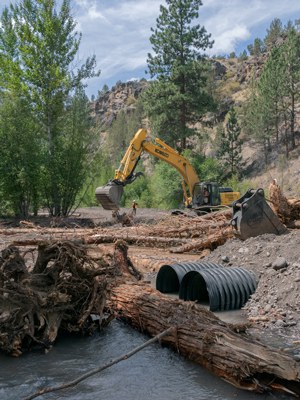Two weeks ago, the Intergovernmental Panel on Climate Change released the first part of its most recent climate change assessment. The physical science basis of Sixth Assessment Report painted a grim picture of all that we are doing to our planet—including the fact that our planet is warming faster than we thought and that our actions are driving extreme weather (e.g., two heatwaves this summer!). It was also an urgent call to action—because things are going to get a lot worse. We all need to take individual action, and we need to support groups working to fight climate change at the local level. One local ray of hope in the climate crisis is that some major stream restoration projects are building resilience into our natural systems so we—human and wild—can all survive the climate crisis.
The Deschutes Land Trust and Upper Deschutes Watershed Council have been partnering on stream restoration projects for nearly 15 years. The Watershed Council provides the restoration expertise and the Land Trust protected lands ripe for restoration projects to benefit fish, wildlife and local communities. Many of these projects have been centered around Whychus Creek, one of our regional jewels that flows through Sisters and provides clean, cold water that flows into the Deschutes River.
But how do stream restoration projects help climate change? They help natural systems adapt and have more defenses to a changing climate. One of the goals of the Whychus Creek restoration project is to restore natural functions of the creek. That means helping the creek get back to a place where it can reconnect with its floodplain, overflow its banks, and store water like it historically would have. This in turn helps the creek (and our region!) weather drought by holding water in the surrounding floodplain when flows are high and then naturally releasing it when flows are low. It also helps mitigate flood events by allowing flood waters to spread out across the floodplain and slow their destructive force. As the climate continues to warm, drought and flooding will happen more often, and the hope is that restored stream systems will be able to respond to these changes more effectively.
Stream restoration can also create or improve climate refugia. Climate refugia are places that will remain buffered from the impacts of climate change and where natural communities will be more able to persist over time. Restoration projects help create refugia by improving and diversifying habitats in and around the stream. This gives plants, fish, and wildlife more places to move, adapt, and recover as the climate warms. It also helps improve water quality and quantity, keeping our water clean and cold. Finally, conserving and protecting refugia helps reduce future greenhouse gas emissions by keeping trees and plants on the landscape absorbing CO2, and keeping soil from eroding so it can sequester carbon.
Conservation and restoration of our lands and waters is climate action. You can take action right here, right now, to keep our planet livable as we face the climate crisis, by supporting these conservation groups and projects, now and into the future.
This story first appeared in the Source Weekly.
Learn more:
- About the Whychus Creek restoration
- About the Land Trust's Climate Change Commitment


